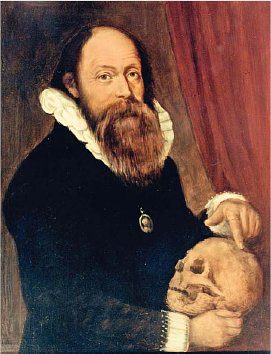
In sixteenth century Europe poor people seeking treatment for their ailments would often first consult a wise woman or, strange to say, even the local hangman.1 The next step up the therapeutic ladder might have been a barber-surgeon, who limited himself Figaro-like to shaving, cutting hair, trimming beards, lancing boils, and blood-letting. Other barber-surgeons extended their practice to treating fractures, burns, ulcers, tumors, gangrene, wounds, hemorrhoids, and varicose veins. Restricted to prescribing remedies only for the outside of the body, they and the apothecaries (who could supply and sell but not prescribe drugs) were looked down on by the physicians, who having university degrees saw themselves as the top of the pyramid,1 walking about in cap and gown and spouting wisdom in Latin as featured by Molière in his plays and Mozart in his operas.
Among the barber-surgeons of that period, Guilhemus Fabricius Hildanus is remembered as a skilled surgeon and learned advocate of the importance of knowing anatomy, as well as being responsible for a prolific literary output.2 Born in 1560 as Wilhelm Fabry in the village of Hilden near Düsseldorf, he came from a family that instead of Schmidt adopted the Latin name of Fabry (faber, fabri – a smith)2. Later he became known as Fabricius Hildanus, according to the fashion of the time for learned men to be referred to by their Latinized name.
From his earliest days Fabricius showed an extraordinary aptitude for scholarship. At school in Cologne he learned Latin, German, French, and some Greek and Hebrew. The loss of his father at age nine made it impossible for him to attend university. Instead he became apprenticed to several barber surgeons, notably in Düsseldorf to the barber-surgeon Cosmas Slotanus (Slot), who had been a pupil of Vesalius and was serving at the court of the Duke of Cleves. There he learned much anatomy and surgery, also medicine from distinguished physicians. After the death of Slotanus in 1585 he left Cleves and for the next few decades was peripatetic, never settling down anywhere for long, and practicing at various times in Metz, Geneva, Bern, Lausanne, Hilden, Worms, and Cologne. In 1587 in Geneva he married Marie Colinet, herself a skillful surgeon and obstetrician, who brought up eight children as well delivering babies, treating fractures, even inventing a magnet for extracting metal particles from the eye, and “proving to be a constant source of help and happiness to her husband all her life. There cannot be many surgeons’ wives in the history of surgery who took such an active part in their husband’s professional life.”2 In 1615 Hildanus was appointed as the official surgeon of the town and Canton of Bern, and settled there for the rest of his life.2,3
Hildanus was a masterful surgeon. His surgical exploits are many. Even during his apprenticeship in Metz he assisted at many difficult surgical procedures, notably fashioning a new nose for a woman who had hers cut off by soldiers during a local war. He performed amputations and operated on gangrenous fingers, strangulated hernias, foreign bodies, bladder stones, lacerations, puncture wounds, depressed fractures of the skull, empyemas, and injuries to the cornea.
His interest in anatomy and dissections developed during his apprenticeship at Cleve, and later he continued to dissect, lecture on anatomy and give public demonstrations, always emphasizing the importance of a thorough knowledge of anatomy. He also re-articulated some skeletons he had dissected, including those of executed criminals, observing that some scapulae had been fractured during torture, and inveighing against this practice by which prisoners might be made to confess crimes they have not committed. He knew anatomy as few surgeons knew at that time.
Despite his peripatetic ways he was a prolific author, writing over 100 letters to his friends and 443 letters now preserved and containing observations on cases of interest, advice and treatment, even observations on a shipwreck, on earthquakes, comets, and the miscarriage of a calf. He published books on gangrene, lithotomy, gunshot wounds, military medicine, plague epidemics, burns, mineral baths, and the uses of anatomy.
Some of his surgical methods are still used today. He developed new techniques for carrying out amputations – often required during the troubled years of the Thirty Years War. For hemostasis and deadening the nerves he applied tourniquets above and below the site of the incision, describing how to make the incision, how to use cautery for hemostasis, how three attendants were to hold down the patient, as well as details of preoperative and postoperative care. He was the first to divide burns into three different degrees such as is still done today; also classified diarrhea and dysentery into various types, describing a special bedpan and an enema syringe with a bulb made of pig’s bladder. For lithotomy he recommended faithful, honest surgeons not given to drunkenness or gambling; advised that the patient should be prepared by diet, purging, bleeding and bathing, and should avoid anger and sadness; and described in detail where the incision should be made and how the stone should be removed.
Hildanus died in 1634 at the age of 74. In Bern his cemetery no longer exists, but his gravestone is in the historical museum, his manuscripts are preserved in the public library, and there is a street called Hildanusstrasse. In his birthplace of Hilden the city fathers have raised a bronze bust in the market place, named streets after him and his wife, and hold periodic marathon-like races (Hildanus Lauf –meaning race) in his honor. He is remembered as one of the founders of scientific surgery and has been called the German Ambroise Paré.
References
- Jűtte R. A seventeenth century German barber-surgeon and his patients. Med Hist 1989; 33:184.
- Jones EW. The life and works of Guilhelmus Fabricius Hildanus (1560-1634). Med Hist 1960; 4:196.
- Gisel A. Guilhelmus Fabricius Hildanus, physician-surgeon, a good and well-loved man. Wien Klin Wochenschr. 1960;72:647 (in German).

Leave a Reply